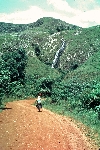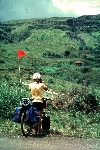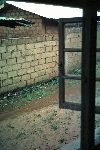| |
 While the people of Bamenda were up and moving around the city
in mass by six --
especially students heading for school -- there seemed to be no restaurants
ready to serve breakfast. The best option for breakfast is the relatively informal
providers (mostly women) who bring a collection of pots from home and set up at tables along
the road, often near intersections. There is some variety of the specifics
in the pots but they tend to be on the theme of a couple choices of each carbohydrate (rice, potatoes, yams, casava, plantain), sauces (tomato based or
greens) and protein (beans, fish, meat, chicken). They may seem informal,
but they are in fact While the people of Bamenda were up and moving around the city
in mass by six --
especially students heading for school -- there seemed to be no restaurants
ready to serve breakfast. The best option for breakfast is the relatively informal
providers (mostly women) who bring a collection of pots from home and set up at tables along
the road, often near intersections. There is some variety of the specifics
in the pots but they tend to be on the theme of a couple choices of each carbohydrate (rice, potatoes, yams, casava, plantain), sauces (tomato based or
greens) and protein (beans, fish, meat, chicken). They may seem informal,
but they are in fact
 very established. At our choice for breakfast this
morning
though
the woman worked from a table outside, she had a covered dining room which was
packed with what seemed like regulars. The only place for us sit was the
"overflow bench" in the front. This worked out fine because the air was
clear and warm and we got a better view of the comings and goings. very established. At our choice for breakfast this
morning
though
the woman worked from a table outside, she had a covered dining room which was
packed with what seemed like regulars. The only place for us sit was the
"overflow bench" in the front. This worked out fine because the air was
clear and warm and we got a better view of the comings and goings.

 It
was a good thing that we had a pretty hardy breakfast because after seven miles
of relatively easy riding there was a tough five mile long Sagbo Hill. Not to
complain too much because it is the hills in the area that give it a lot of its
beauty. At
the top there was beautiful fertile rolling It
was a good thing that we had a pretty hardy breakfast because after seven miles
of relatively easy riding there was a tough five mile long Sagbo Hill. Not to
complain too much because it is the hills in the area that give it a lot of its
beauty. At
the top there was beautiful fertile rolling countryside, complete with countryside, complete with
 water
falls cascading off the nearby escarpment. And as the 1960's song says, "What goes up must come down.
Spinning wheel have got to go round." As
much as the road climbed earlier, it descended later. But if it wasn't for
the views this would not quite be justice -- water
falls cascading off the nearby escarpment. And as the 1960's song says, "What goes up must come down.
Spinning wheel have got to go round." As
much as the road climbed earlier, it descended later. But if it wasn't for
the views this would not quite be justice --
 it might take
more than an hour to c it might take
more than an hour to c limb five miles and it will only take about ten minutes to
loose it. It is not only the panoramic views that are a reward, but also
details like the variety of crops that are grown, flowers and the architectural
styles. limb five miles and it will only take about ten minutes to
loose it. It is not only the panoramic views that are a reward, but also
details like the variety of crops that are grown, flowers and the architectural
styles.



 The final leg was on the floor of the Upper Nun Valley, which is quite flat.
The is one village that stands out because it is architecturally different, the
mosque, which are rare in this area is prominent and the people are distinctive
in dress, adornment and appearance. The explanation is that it is a Fulani
or Fulbe village. This is an ethnic group The final leg was on the floor of the Upper Nun Valley, which is quite flat.
The is one village that stands out because it is architecturally different, the
mosque, which are rare in this area is prominent and the people are distinctive
in dress, adornment and appearance. The explanation is that it is a Fulani
or Fulbe village. This is an ethnic group
 that
traces its roots to Senegal. The are traditionally cattle herders and
warrior horsemen. Over centuries they have migrated overland across
the Sahel (grassland zone to the south of the Sahara). They
are a significant ethnic group in the north of Cameroon and their aggressive
arrival there a couple century ago created a domino effect of other ethnic
groups moving/being pushed south. The pocket of Fulani here is very that
traces its roots to Senegal. The are traditionally cattle herders and
warrior horsemen. Over centuries they have migrated overland across
the Sahel (grassland zone to the south of the Sahara). They
are a significant ethnic group in the north of Cameroon and their aggressive
arrival there a couple century ago created a domino effect of other ethnic
groups moving/being pushed south. The pocket of Fulani here is very isolated and there arrival was peaceful.
isolated and there arrival was peaceful.
 Ndop
is a quite residential and trading town. It seems to be a cross roads for a
number of road going out into the Ndop plains. It provide a variety of
government service (post office, utility offices, etc), gas stations and mechanics, a daily produce market
and the assorted shops typical of a Cameroonian town: tailors, bars, beauty
salons, dry goods, more Ndop
is a quite residential and trading town. It seems to be a cross roads for a
number of road going out into the Ndop plains. It provide a variety of
government service (post office, utility offices, etc), gas stations and mechanics, a daily produce market
and the assorted shops typical of a Cameroonian town: tailors, bars, beauty
salons, dry goods, more
 bars, bakery, auto and motorcycle parts, photo studio
and more bars. Outside of the center, people have food gardens around
their houses. It is a nice walking town. bars, bakery, auto and motorcycle parts, photo studio
and more bars. Outside of the center, people have food gardens around
their houses. It is a nice walking town.
We stayed at the Green Valley Resort. I
bring this up to point out it would probably be called the
 Green
Valley Motel any place in North America. It was in a residential area,
very quiet and had a nice courtyard, but lack any amenities that you might
associate with a resort, except for the presence of rooms. It advertised
itself on a sign by the main road as "hectic spot for weekends and other leisure
moments." Green
Valley Motel any place in North America. It was in a residential area,
very quiet and had a nice courtyard, but lack any amenities that you might
associate with a resort, except for the presence of rooms. It advertised
itself on a sign by the main road as "hectic spot for weekends and other leisure
moments."
Today's task of mapping the local languages was almost as easy as mapping the
villages. Leaving Bamenda we passed through Nkwen, where they speak
Mendankwe-Nkwen. Seven miles down the road is Bambui, where they speak
Bambili-Bambui and three miles after that is Bamali, where they speak Bamali.
T he first two languages are in the Mbam-Nkam>Ngemba group and Bamali is in the
Mbam-Nkam>Nun group. After Sabgo Hill it became a little more complex and
fuzzy again. In the Upper Nun Valley a number of languages are spoken,
most in the Narrow Grassfields>Ring>North group. Around Ndop Bamunka seems
to be the primary language, but there are also some other Ring languages and Nun
languages, and at least one Fulani (or Fulbe) village, which migrated from
northern Cameroon, but has its linguistic roots in Senegal. The full
description of the language is
Niger-Congo>Atlantic-Congo>Atlantic>Northern> Senegambia>Bantoid>Fulani-Wolof>Fula>Eastern>Fulfulde. he first two languages are in the Mbam-Nkam>Ngemba group and Bamali is in the
Mbam-Nkam>Nun group. After Sabgo Hill it became a little more complex and
fuzzy again. In the Upper Nun Valley a number of languages are spoken,
most in the Narrow Grassfields>Ring>North group. Around Ndop Bamunka seems
to be the primary language, but there are also some other Ring languages and Nun
languages, and at least one Fulani (or Fulbe) village, which migrated from
northern Cameroon, but has its linguistic roots in Senegal. The full
description of the language is
Niger-Congo>Atlantic-Congo>Atlantic>Northern> Senegambia>Bantoid>Fulani-Wolof>Fula>Eastern>Fulfulde.
|
Addendum:
A noteworthy change in the road from Bamenda to
Ndop since 2000 is the asphalt surface. Here are a few archive photos
from earlier times:











 |






























 Please
contact us
Please
contact us